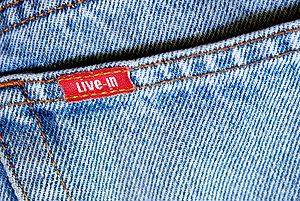Because it is hidden in our walls, most of us do not really think about insulation or what it's made of. But more and more people are looking to "green" options for insulating their homes and buildings, not only because it's healthier for the occupants, but also because the manufacture and use of green insulation is better for the environment. Mainstream insulation can contain fiberglass, formaldehyde, and other toxic components. Here are some examples of eco-friendly, healthy insulation materials you may not have thought of, but which can be great alternatives to traditional insulation material choices.
- Jeans
| (Photo credit: Wikipedia) |
- Cellulose
Cellulose is made from recycled or finely-shredded newspaper. There are options as to its installation: it can be blown into crevices and walls, and it's also available in boards and pads. It is also chemically treated with non-toxic substances to reduce susceptibility to fire and mold.
- Straw
One of the oldest insulators, straw is making a comeback. Tightly-bound bales are stacked within wall studs and covered with plaster. Baled in this way, straw is fire-resistant but prone to moisture absorption, so it's not a good option for humid climates.
| A sample of a sheep wool insulation batt. (Photo credit: Wikipedia) |
Another common clothing ingredient, wool makes excellent insulation. You have the option of having it treated chemically to reduce the risk of insect infestation. It has been used successfully without being so treated, and if you want to avoid chemicals altogether, you can try it untreated. Wool is naturally resistant to fire.
- Hemp
Naturally resistant to insects, hemp does not need to be chemically treated with insecticide. It is fairly dense and offers insulating properties similar to wool.
- Spray Foam
There are such things as eco-friendly, spray foam insulations. Water-based spray is a mix of carbon dioxide and water, and it is sprayed into spaces where it swells and fills the space like traditional, synthetic foams. Another kind of spray foam insulation is made with a combination of naturally-derived magnesium dioxide and compressed air. It is mold and fire resistant, and is particularly good insulation against noise.
Whether you are re-insulating an existing home or building your own structure from the ground up, there are quite a few options for non-toxic insulation that will improve your indoor air quality and be easier on the planet.



No comments:
Post a Comment